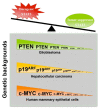STAT3 in Cancer-Friend or Foe?
- PMID: 24995504
- PMCID: PMC4190548
- DOI: 10.3390/cancers6031408
STAT3 in Cancer-Friend or Foe?
Abstract
The roles and significance of STAT3 in cancer biology have been extensively studied for more than a decade. Mounting evidence has shown that constitutive activation of STAT3 is a frequent biochemical aberrancy in cancer cells, and this abnormality directly contributes to tumorigenesis and shapes many malignant phenotypes in cancer cells. Nevertheless, results from more recent experimental and clinicopathologic studies have suggested that STAT3 also can exert tumor suppressor effects under specific conditions. Importantly, some of these studies have demonstrated that STAT3 can function either as an oncoprotein or a tumor suppressor in the same cell type, depending on the specific genetic background or presence/absence of specific coexisting biochemical defects. Thus, in the context of cancer biology, STAT3 can be a friend or foe. In the first half of this review, we will highlight the "evil" features of STAT3 by summarizing its oncogenic functions and mechanisms. The differences between the canonical and non-canonical pathway will be highlighted. In the second half, we will summarize the evidence supporting that STAT3 can function as a tumor suppressor. To explain how STAT3 may mediate its tumor suppressor effects, we will discuss several possible mechanisms, one of which is linked to the role of STAT3β, one of the two STAT3 splicing isoforms. Taken together, it is clear that the roles of STAT3 in cancer are multi-faceted and far more complicated than one appreciated previously. The new knowledge has provided us with new approaches and strategies when we evaluate STAT3 as a prognostic biomarker or therapeutic target.
Figures



References
-
- Pensa S., Regis G., Boselli D., Novelli F., Poli V. Stat1 and STAT3 in Tumorigenesis: Two Sides of the Same Coin? Landes Bioscience; Austin, TX, USA: 2009.
LinkOut - more resources
Full Text Sources
Other Literature Sources
Miscellaneous

